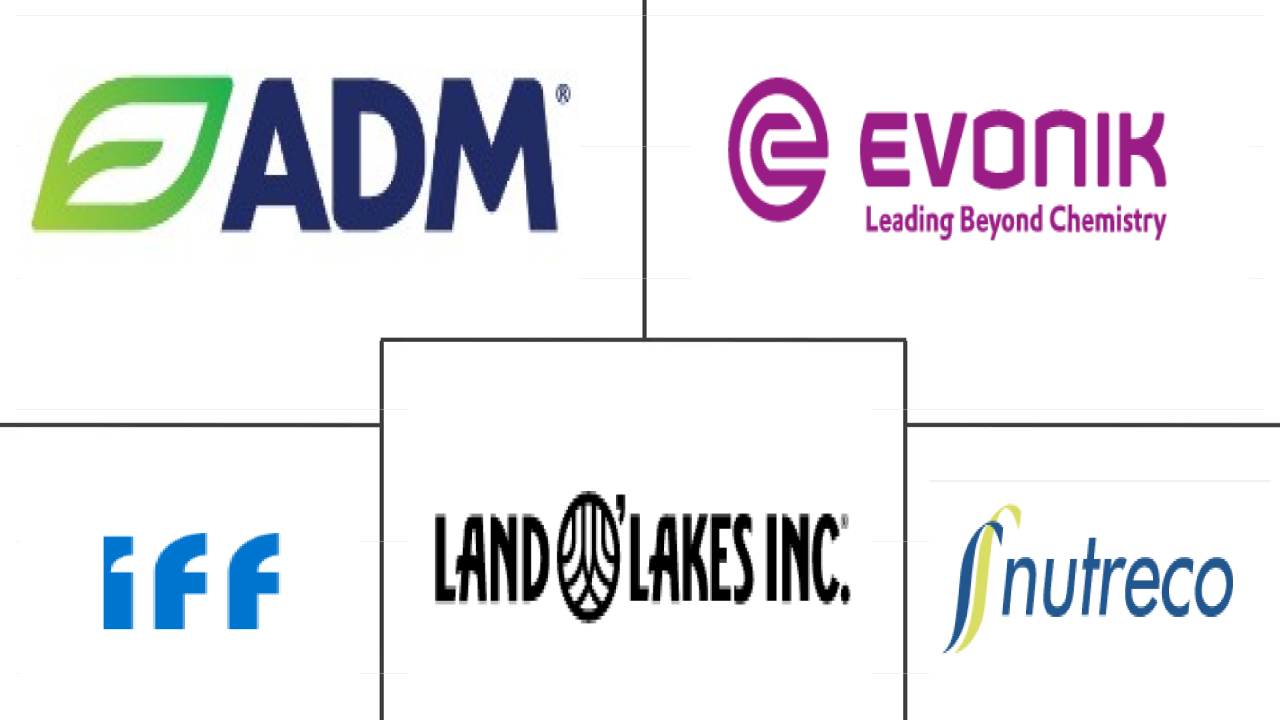Market Size of north america feed amino acids Industry
|
|
Study Period | 2017 - 2029 |
|
|
Market Size (2024) | USD 1.97 Billion |
|
|
Market Size (2029) | USD 2.60 Billion |
|
|
Largest Share by Sub Additive | Lysine |
|
|
CAGR (2024 - 2029) | 5.66 % |
|
|
Largest Share by Country | United States |
Major Players |
||

|
||
|
*Disclaimer: Major Players sorted in no particular order |
North America Feed Amino Acids Market Analysis
The North America Feed Amino Acids Market size is estimated at 1.97 billion USD in 2024, and is expected to reach 2.60 billion USD by 2029, growing at a CAGR of 5.66% during the forecast period (2024-2029).
1.97 Billion
Market Size in 2024 (USD)
2.60 Billion
Market Size in 2029 (USD)
7.67 %
CAGR (2017-2023)
5.66 %
CAGR (2024-2029)
Largest Market by Sub-Additive
42.93 %
value share, Lysine, 2023
Lysine demand is the highest in the region to reduce the feed cost by balancing the amino acid composition in livestock diets and increasing the demand for poultry and pig meat.
Largest Market by Country
70.28 %
value share, United States, 2023
The United States is the largest country because the increased poultry meat consumption in both households and the commercial food industry has promoted amino acid consumption.
Fastest-growing Market by Sub-Additive
6.34 %
Projected CAGR, Methionine, 2024-2029
Owing to benefits such as optimum body weight, improved gut health, and easy digestion in animals, methionine is the fastest-growing segment in the region.
Fastest-growing Market by Country
6.20 %
Projected CAGR, United States, 2024-2029
The increase in the demand for meat and livestock products and feed production has helped the US market be the fastest-growing region.
Leading Market Player
14.84 %
market share, IFF(Danisco Animal Nutrition), 2022

IFF (Danisco Animal Nutrition) is the market leader because the company has invested USD 860 million in product innovation and uses advanced technologies to produce products.
- The feed amino acids market in the region saw a substantial increase in 2019, with a growth rate of 15.4% compared to the prior year. This growth is attributed to the rise in feed production, specifically for ruminants, with every type of amino acid used in feed experiencing an increase in value.
- In North America, lysine and methionine were the most commonly used feed amino acid sub-additives in 2022, owing to their essential role in animal gut health and digestion. Tryptophan and methionine are anticipated to exhibit the highest growth rates during the forecast period, with a projected CAGR of 6.3%. While tryptophan is costlier than other amino acids and therefore constitutes a smaller share of the market, it plays a crucial role in promoting growth and increasing feed intake during the pre-weaning stage of an animal's life cycle.
- The United States is the largest country in the feed amino acids market, with lysine and methionine accounting for nearly 70% of the market in 2022. The country's growth rate in this market is the highest in North America, partly due to the affordability and moderate dosage rate of lysine.
- Despite varying costs, all feed amino acid types are projected to grow at similar rates in the forecast period throughout the region, given their ability to provide various benefits for animals, including promoting gut health, muscle development, and egg formation. These benefits extend to a range of animal types and serve diverse purposes. The market is expected to grow due to these benefits, driving the demand for feed amino acids.
- In 2022, the North American feed amino acids market accounted for 21% of the total feed additives market, with a value of USD 1.8 billion. This is due to the increasing demand for meat and meat products, leading to the rise in the usage of amino acids in the animal feed industry. The market value increased by 15.4% in 2019 compared to 2018, driven by the increase in feed production in the region, particularly in the United States.
- Poultry animals were the most significant users of feed amino acids in 2022, with a market value of USD 0.7 billion, representing 41.7% of theNorth American feed amino acid market. Ruminants followed with a market share of 35.1% in the same year. The consumption of poultry meat in households and the commercial food industry has increased the usage of amino acids, with broilers accounting for over 70% of the total feed amino acid usage in poultry animals.
- Lysine and methionine were the most commonly used amino acids in 2022, accounting for 43.2% and 29.8% of the total amino acid market in the region, respectively. These amino acids are essential for animal growth and development since animal tissues cannot synthesize them or cannot make the adequate amount needed.
- The United States is the largest feed amino acid market in North America, accounting for 70% of the total feed amino acid market in 2022. The country was also the fastest-growing in terms of the feed amino acids market, with a CAGR of 6.2% during the forecast period. The demand for meat and meat products, along with the increasing demand for feed that enhances growth, development, and resistance to diseases, is expected to drive the North American feed amino acids market at a CAGR of 5.6% during the forecast period.
North America Feed Amino Acids Industry Segmentation North America Feed Amino Acids Industry Segmentation
Lysine, Methionine, Threonine, Tryptophan are covered as segments by Sub Additive. Aquaculture, Poultry, Ruminants, Swine are covered as segments by Animal. Canada, Mexico, United States are covered as segments by Country.
- The feed amino acids market in the region saw a substantial increase in 2019, with a growth rate of 15.4% compared to the prior year. This growth is attributed to the rise in feed production, specifically for ruminants, with every type of amino acid used in feed experiencing an increase in value.
- In North America, lysine and methionine were the most commonly used feed amino acid sub-additives in 2022, owing to their essential role in animal gut health and digestion. Tryptophan and methionine are anticipated to exhibit the highest growth rates during the forecast period, with a projected CAGR of 6.3%. While tryptophan is costlier than other amino acids and therefore constitutes a smaller share of the market, it plays a crucial role in promoting growth and increasing feed intake during the pre-weaning stage of an animal's life cycle.
- The United States is the largest country in the feed amino acids market, with lysine and methionine accounting for nearly 70% of the market in 2022. The country's growth rate in this market is the highest in North America, partly due to the affordability and moderate dosage rate of lysine.
- Despite varying costs, all feed amino acid types are projected to grow at similar rates in the forecast period throughout the region, given their ability to provide various benefits for animals, including promoting gut health, muscle development, and egg formation. These benefits extend to a range of animal types and serve diverse purposes. The market is expected to grow due to these benefits, driving the demand for feed amino acids.
| Sub Additive | |
| Lysine | |
| Methionine | |
| Threonine | |
| Tryptophan | |
| Other Amino Acids |
| Animal | |||||||
| |||||||
| |||||||
| |||||||
| Swine | |||||||
| Other Animals |
| Country | |
| Canada | |
| Mexico | |
| United States | |
| Rest of North America |
North America Feed Amino Acids Market Size Summary
The North America Feed Amino Acids Market is experiencing significant growth, driven by the increasing demand for animal feed, particularly for ruminants and poultry. The market is characterized by the widespread use of essential amino acids like lysine and methionine, which are crucial for animal health and development. The United States leads the market, benefiting from its large-scale poultry production and the affordability of key amino acids. The region's market growth is supported by the rising consumption of meat and meat products, which in turn boosts the demand for feed additives that enhance animal growth and health. The poultry industry, in particular, has seen substantial expansion, with broilers being the primary consumers of feed amino acids due to their rapid growth and high market demand.
In addition to poultry, the aquaculture sector is also contributing to the market's expansion, albeit to a lesser extent. The demand for nutritionally balanced feed for fish and other aquatic species is on the rise, driven by changing dietary preferences and the health benefits associated with fish consumption. The market is moderately consolidated, with major players like Archer Daniel Midland Co., Evonik Industries AG, and others dominating the landscape. Strategic acquisitions and partnerships, such as Novus International's acquisition of Agrivida and Evonik's collaboration with BASF, are shaping the market dynamics by enhancing product offerings and reducing environmental impacts. Overall, the North America Feed Amino Acids Market is poised for continued growth, supported by the diverse applications of amino acids in animal nutrition and the increasing demand for sustainable and efficient feed solutions.
North America Feed Amino Acids Market Size - Table of Contents
-
1. MARKET SEGMENTATION (includes market size in Value in USD and Volume, Forecasts up to 2029 and analysis of growth prospects)
-
1.1 Sub Additive
-
1.1.1 Lysine
-
1.1.2 Methionine
-
1.1.3 Threonine
-
1.1.4 Tryptophan
-
1.1.5 Other Amino Acids
-
-
1.2 Animal
-
1.2.1 Aquaculture
-
1.2.1.1 By Sub Animal
-
1.2.1.1.1 Fish
-
1.2.1.1.2 Shrimp
-
1.2.1.1.3 Other Aquaculture Species
-
-
-
1.2.2 Poultry
-
1.2.2.1 By Sub Animal
-
1.2.2.1.1 Broiler
-
1.2.2.1.2 Layer
-
1.2.2.1.3 Other Poultry Birds
-
-
-
1.2.3 Ruminants
-
1.2.3.1 By Sub Animal
-
1.2.3.1.1 Beef Cattle
-
1.2.3.1.2 Dairy Cattle
-
1.2.3.1.3 Other Ruminants
-
-
-
1.2.4 Swine
-
1.2.5 Other Animals
-
-
1.3 Country
-
1.3.1 Canada
-
1.3.2 Mexico
-
1.3.3 United States
-
1.3.4 Rest of North America
-
-
North America Feed Amino Acids Market Size FAQs
How big is the North America Feed Amino Acids Market?
The North America Feed Amino Acids Market size is expected to reach USD 1.97 billion in 2024 and grow at a CAGR of 5.66% to reach USD 2.60 billion by 2029.
What is the current North America Feed Amino Acids Market size?
In 2024, the North America Feed Amino Acids Market size is expected to reach USD 1.97 billion.

